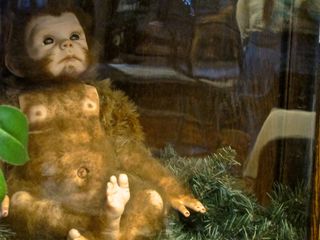Cryptozoology: Does It Matter If Bigfoot Is Real?

The study of extremely rare or mythical creatures like Bigfoot, called cryptozoology, is generally considered a fringe science, lacking the type of robust analysis required to appear in peer-reviewed scientific journals.
But for Loren Coleman, owner of the world's only international cryptozoology museum in Portland, Maine, such accusations are beside the point. The fun is in the unknown.
For that reason, his museum offers visitors an educational experience and a chance to consider yet-to-be-discovered creatures on Earth. His motto is: "Enjoy the quest," according to museum docent Sarah McCann. [Photos: Take a Tour of the International Cryptozoology Museum].
"The mystery is what is fun about it," McCann told LiveScience. "There will always be mysteries out there. Whether or not Bigfoot is real doesn't matter terribly."
Truth in the terrors?
Cryptozoology has existed in certain forms for centuries, with roots in native folklore and mythology. The Yeti, for example, appeared in native Nepalese legends dating back to the fourth century B.C., and only later attained the popularized name Abominable Snowman from British climbers who found suspicious footprints on Mount Everest in the 1920s.
This rich history comes to life during McCann's 30-minute tours through the two main rooms of the museum, which contain a total of about 10,000 pieces of paraphernalia ranging from purported Bigfoot footprint casts, to jackalope taxidermy, to a black-and-white photo of two men standing above what appears to be some sort of unidentifiable sea monster, sent to the museum anonymously without a note.
Sign up for the Live Science daily newsletter now
Get the world’s most fascinating discoveries delivered straight to your inbox.
Along the tour, McCann offers pieces of evidence for and against the existence of the various creatures on display — collectively known as cryptids, or animals whose existence is unsubstantiated — providing anecdotes passed down from cryptozoologists regarding the quality of evidence and the credibility of those claiming to have made the sighting. She then encourages visitors to come to their own conclusions for each case.
For example, McCann personally believes that the sophistication of Bigfoot's movements in the famous 1967 Patterson Bigfoot film — the widely distributed grainy footage of a large beast tromping through Bluff Creek, Calif., taken by a man named Roger Patterson — surpasses the capabilities of technology of 1960s film. Costumes from the earliest episodes of "Star Trek," which premiered around the same time, do not compare in intricacy, McCann said. For this reason, she remains cautiously optimistic that the video could be real.
Tools of the Trade
Coleman, who studied anthropology and zoology in college and earned a master's degree in social work before committing full-time to cryptozoology, also remains cautiously optimistic about the existence of cryptids. But he emphasizes the cautiousness of his optimism, particularly when assessing a new specimen presented to him by novice cryptozoologists.

"The first thing that I always examine is the person that brings me the evidence," Coleman told LiveScience during a recent visit to the museum. "Do they have credibility, and why are they doing this? Are they trying to prove something, trying to make money, or trying for fame? Or have they really just had an extraordinary encounter, and are just trying to find some psychological safety in finding someone who will talk to them about it?"
After this initial assessment, Coleman examines the physical evidence available, which may include items such as pieces of hair, feces, footprints, photographs or simply personal anecdotes. Physical evidence is usually more abundant for land-based creatures like Bigfoot than for the more elusive underwater Loch Ness monster, Coleman said. [Rumor or Reality: The Creatures of Cryptozoology]
"A lot of people say 'Do you believe in the Loch Ness monster?' and I always have to say I don't believe in any of this," Coleman said. "Because belief is about religion, it's about faith. I accept or deny the evidence."
Hoaxes vs. honest mistakes
Coleman says 85 percent to 90 percent of the cases he is presented with are clear hoaxes. Purported Bigfoot tracks are often too uniform to be real, or the toes are too square, or the print itself does not have the texture of a true animal print.
Still, the remaining 10 to 15 percent either remain open cases under investigation, or have been honest misidentifications that have since been proven wrong, such as a purported demon found in rural Maine that DNA analyses later proved was actually the dead body of a domesticated dog.
While cryptozoologists generally enjoy the mystery of the unknown, McCann says that substantiating the existence of any cryptid would be even more tantalizing for her.
"I think it would just open up a whole new avenue for learning about their behaviors, diets and evolutionary history," McCann said. "I think that learning that they exist is just the tip of the iceberg."
Coleman hopes to expand his museum in the next several years to a larger space so that he can display his 400 boxes' worth of additional materials that he keeps in storage, including 40,000 books on cryptozoology that he would eventually like to turn into a library within the museum.
Follow Laura Poppick on Twitter. Follow LiveScience on Twitter, Facebook and Google+. Original article on LiveScience.

